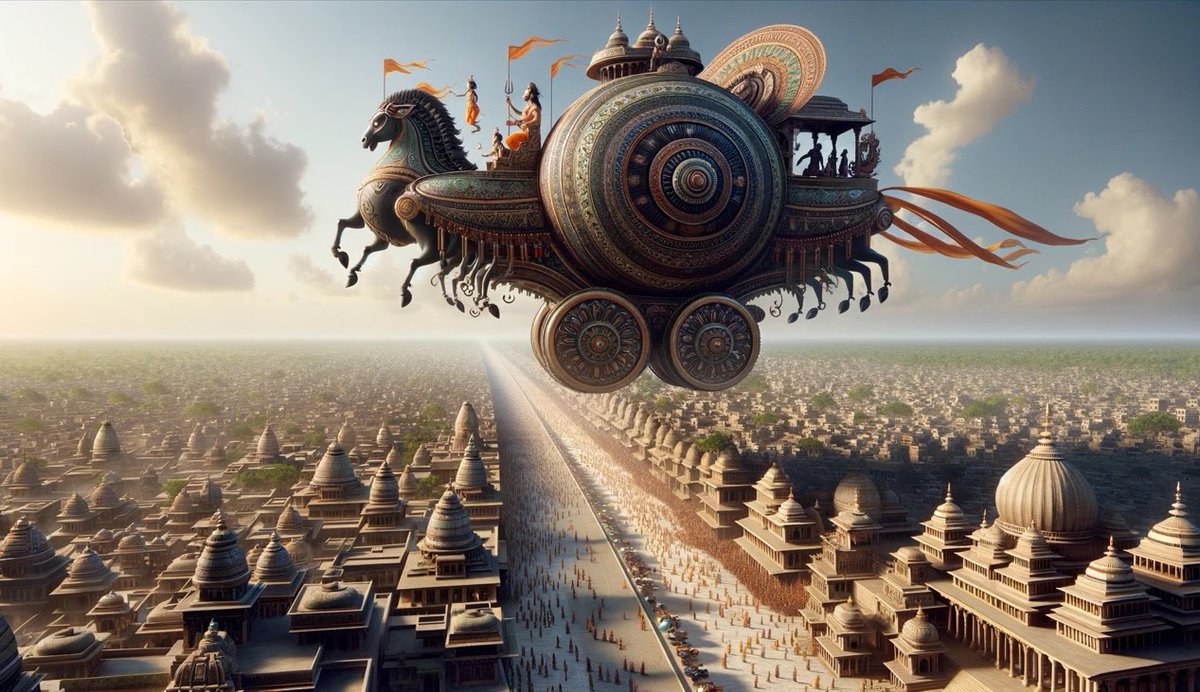Pushpaka Vimana, Conceptualizing Vedic Technology
lets know in this thread:
1) The Pushpaka Vimana, as detailed in Hindu literature and epitomized in the epic Ramayana, is not just a mythical symbol but a fusion of spiritual narrative and ancient technological wonder. This mythical flying chariot, or aircraft, has captured the human imagination, bridging divine narratives with notions of advanced ancient technology. The Sanskrit term vimāna (विमान) translates to "measuring out" or "traversing," indicating a vehicle crafted for spanning great distances. .
lets know in this thread:
1) The Pushpaka Vimana, as detailed in Hindu literature and epitomized in the epic Ramayana, is not just a mythical symbol but a fusion of spiritual narrative and ancient technological wonder. This mythical flying chariot, or aircraft, has captured the human imagination, bridging divine narratives with notions of advanced ancient technology. The Sanskrit term vimāna (विमान) translates to "measuring out" or "traversing," indicating a vehicle crafted for spanning great distances. .

2) Pushpaka Vimana in Ramayana:
The Pushpaka Vimana is an integral part of the Ramayana's narrative. Crafted by Vishwakarma for Brahma, it later became the possession of Kubera, the god of wealth, and was eventually seized by the demon king Ravana. Its most notorious use was in the abduction of Sita, adding a layer of complexity to its story. Following Ravana's defeat, the Pushpaka Vimana became the vehicle for Lord Rama, Sita, and Lakshmana's triumphant return to Ayodhya, symbolizing the triumph of good over evil and the restoration of moral order.
The Pushpaka Vimana is an integral part of the Ramayana's narrative. Crafted by Vishwakarma for Brahma, it later became the possession of Kubera, the god of wealth, and was eventually seized by the demon king Ravana. Its most notorious use was in the abduction of Sita, adding a layer of complexity to its story. Following Ravana's defeat, the Pushpaka Vimana became the vehicle for Lord Rama, Sita, and Lakshmana's triumphant return to Ayodhya, symbolizing the triumph of good over evil and the restoration of moral order.

3) The Return to Ayodhya :
This return in the Pushpaka Vimana was not just a mere journey; it was a restoration of dharma in Ayodhya. The vehicle's description as an ancient technological marvel, adjusting its size and traveling at the speed of thought, emphasizes its significance. The arrival of Rama, Sita, and Lakshmana in Ayodhya was celebrated with grandeur, marking the beginning of Ram Rajya, an era of justice and prosperity.
This return in the Pushpaka Vimana was not just a mere journey; it was a restoration of dharma in Ayodhya. The vehicle's description as an ancient technological marvel, adjusting its size and traveling at the speed of thought, emphasizes its significance. The arrival of Rama, Sita, and Lakshmana in Ayodhya was celebrated with grandeur, marking the beginning of Ram Rajya, an era of justice and prosperity.
4) The Pushpaka Vimana, as depicted in ancient Hindu texts like the Ramayana and various Puranas, is an example of the rich imagination and conceptual depth in ancient Indian mythology. While the actual technical workings of the Vimana are not described in detail in these texts, its portrayal often suggests a blend of mystical powers and advanced technology, far beyond the understanding of that era. Here are some speculative aspects based on the descriptions in the texts:
1. Advanced Propulsion and Navigation: The Pushpaka Vimana was said to move at the speed of thought and could navigate vast distances swiftly, implying a propulsion system far more advanced than any known contemporary technology. It might have been thought-controlled or operated using some form of advanced artificial intelligence.
2. Size Adjustment: One of the most remarkable features described is its ability to expand or contract in size according to the number of passengers. This suggests a form of molecular or atomic manipulation technology or an understanding of space that allows physical objects to change their dimensions.
1. Advanced Propulsion and Navigation: The Pushpaka Vimana was said to move at the speed of thought and could navigate vast distances swiftly, implying a propulsion system far more advanced than any known contemporary technology. It might have been thought-controlled or operated using some form of advanced artificial intelligence.
2. Size Adjustment: One of the most remarkable features described is its ability to expand or contract in size according to the number of passengers. This suggests a form of molecular or atomic manipulation technology or an understanding of space that allows physical objects to change their dimensions.

5) 3. Material Composition: The Vimana was likely made from materials unknown to modern science, possibly combining both earthly and extraterrestrial elements. These materials could have properties like lightness, strength, and the ability to withstand high velocities and temperatures.
4. Energy Source: The energy source powering the Pushpaka Vimana might have been something akin to a compact fusion reactor or an advanced form of renewable energy, allowing it to travel vast distances without refueling.
5. Defensive Mechanisms: Given its use in various mythological battles, the Vimana might have been equipped with advanced defensive systems, possibly including energy shields or cloaking technology to make it invisible or impervious to attacks.
6. Sensory and Communication Systems: The Vimana could have had sophisticated sensory equipment to navigate and communicate, possibly harnessing quantum communication or other forms of advanced signal processing.
4. Energy Source: The energy source powering the Pushpaka Vimana might have been something akin to a compact fusion reactor or an advanced form of renewable energy, allowing it to travel vast distances without refueling.
5. Defensive Mechanisms: Given its use in various mythological battles, the Vimana might have been equipped with advanced defensive systems, possibly including energy shields or cloaking technology to make it invisible or impervious to attacks.
6. Sensory and Communication Systems: The Vimana could have had sophisticated sensory equipment to navigate and communicate, possibly harnessing quantum communication or other forms of advanced signal processing.

• • •
Missing some Tweet in this thread? You can try to
force a refresh


















